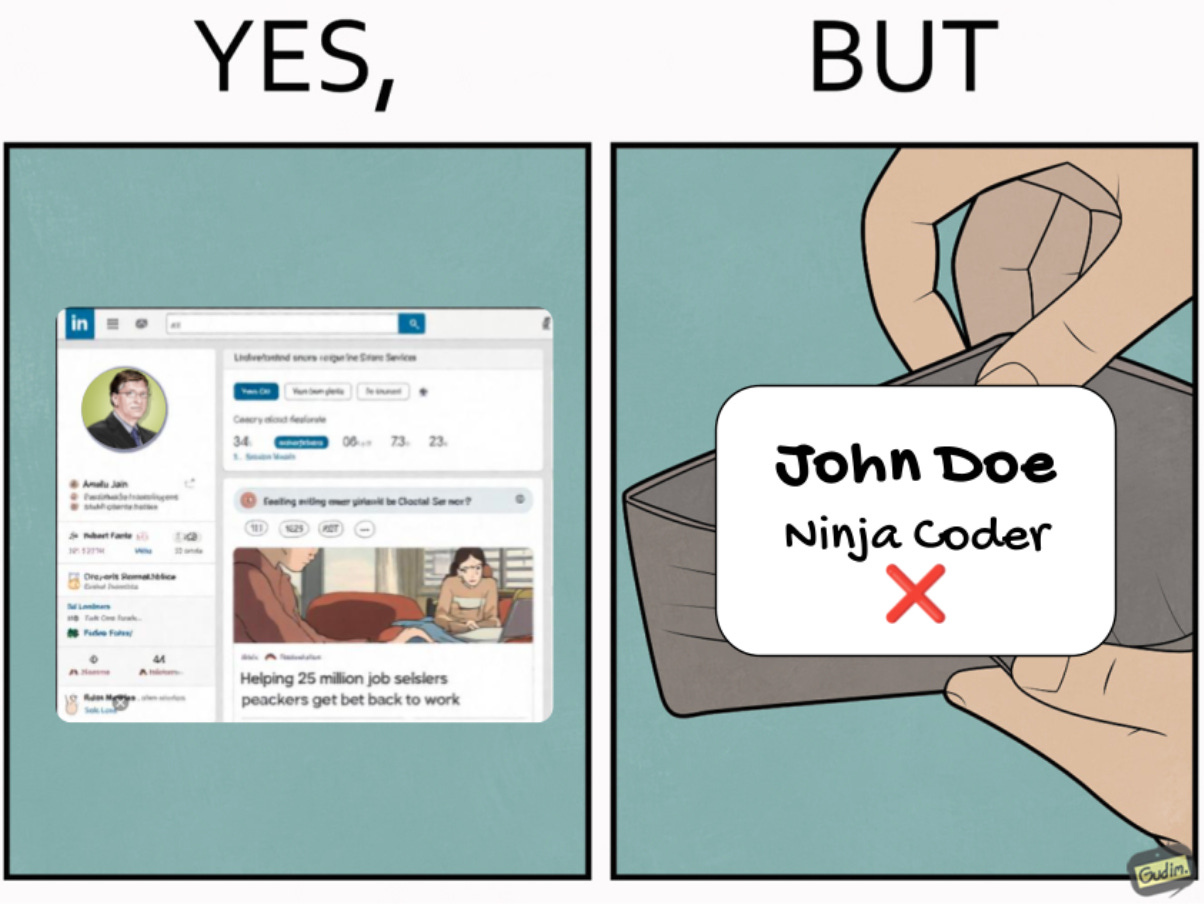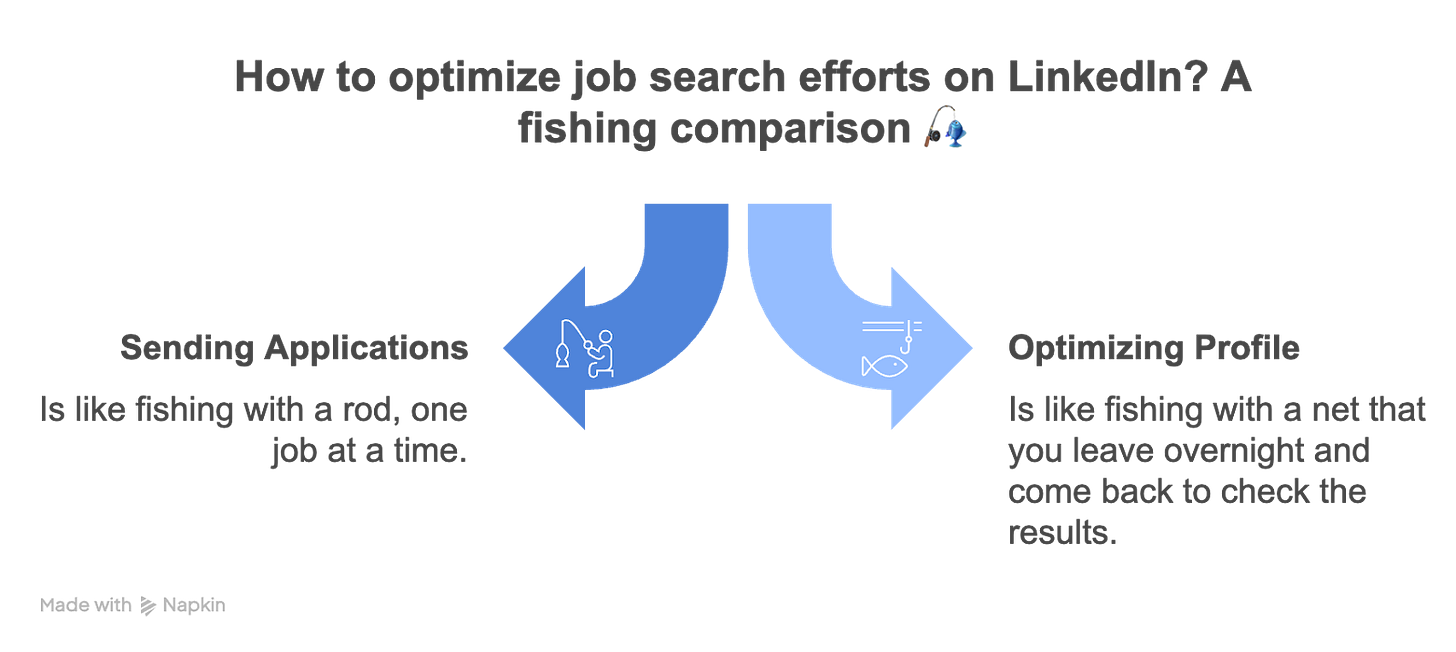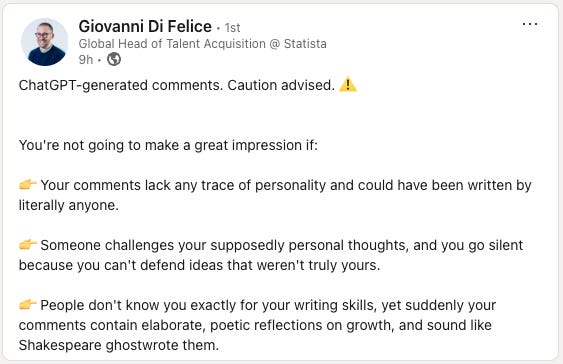If you’re dreaming of building your career abroad, you’re probably wondering whether LinkedIn can actually move the needle. Can you get a job abroad through LinkedIn?
The answer: Yes, but…
Because yes, LinkedIn will work, but if you treat your profile like a landing page, not a forgotten resume from 2019.
This is in line with other stories I’ve covered in The Global Move. In my How Recruiters at Big Tech Actually Hire article, my friend and colleague Anna, a hiring executive, revealed that around 80% of positions in tech are actively sourced by the recruiting team.
So, some people in this community might think LinkedIn is just a passive directory which they can use to prove their experience. But, if used right, it becomes your inbound job funnel, especially if you want recruiters from other countries to find you. Maybe you’re a developer in Brazil thinking about Berlin, or a designer in Delhi curious about working in Toronto. Either way, LinkedIn can definitely work as your way in.
So, if you were thinking: “I’ll get a job abroad through LinkedIn thanks to the Quick Apply option,” then you should flip your script: You’ll get the job abroad because you’ll make your profile so compelling that recruiters will find you, and not the other way around.
This guide breaks down several tips on how to make your profile stand out to international recruiters and turn LinkedIn into a real job search tool. Spoiler: it takes more than just switching on the “Open to work” badge. It has more to do with becoming visible, being clear with what you want others to notice about you, and getting seen.
Just like when I wrote my article debunking the central myth around the ATS (“You need to get past it! It’s automatically rejecting you!”), I called in for expert help to get a complete view of this matter. On this occasion, I called Eli Gündüz, Principal Tech Recruiter at Atlassian (Jira crowd, raise your hands!) and a freelance tech career coach, so that he could weigh in. Eli runs Careersy Coaching, a service with which he can help you land attractive job offers in less than three months and without spamming the Quick Apply button. Many of the recommendations you’ll find here were brought up by him, and I know they’ll help The Global Move readers.
This may sound obvious, but it’s still the most overlooked part of the process: give your LinkedIn profile a professional polish. A recruiter scanning 100 profiles isn’t going to click on the one with no photo, a one-liner About section, and a job title like “developer.”
Here’s what to fix right away:
Photo: Use a clear, friendly headshot. No sunglasses, no group pics, no party shots cropped weirdly. If you wouldn’t use it on a passport or conference badge, don’t use it here.
Text within this block will maintain its original spacing when published
👨💼 Is the AI headshot surge a balm or a curse? As a recruiter myself, I have mixed feelings about the AI headshots. AI headshots are still unmistakingly AI. The skin is too clean. There are artifacts here and there. I still suggest that you use a professional, real-world picture instead of generating an AI headshot.Headline: Instead of just “Software Developer,” say “Backend Developer – Java | Spring Boot | 6 YOE | Open to relocation to [Country Name].” That one line shapes what kinds of opportunities you attract.
Text within this block will maintain its original spacing when published
📌 Eli, who actively sources tech talent, told me that the [Country Name] bit is critical because it impacts on search efforts. Like he said: “When I’m recruiting talent in other geos, I typically type: Open to relocation to Australia.” 🔎 About the Boolean search mechanism in recruiting: If you’ve been reading my other articles on The Global Move, you’ll have realized that recruiters and sourcers use Boolean search operators to find or screen candidates. So you’re positioning yourself differently by saying “Backend Developer” instead of “Software Developer.”About section: Think of it as a personal pitch. Avoid generic AI-generated blurbs (yes, people can tell). If English isn’t your first language, write simply and clearly: short paragraphs, active voice, no buzzwords, and maybe avoid the em dash (—), which I defend, and many writers love it, but well, many people are untrustworthy of an impeccable text with that dash. Try:
I'm a software engineer with 5 years of experience who has built scalable web services that supported the operations of 25k companies in EMEA. I’m keen about solving real-world problems, and I’m currently open to opportunities in Europe. My ideal destination is the Netherlands, Germany, or the UK. But I’m open to discussing any other options that you have.
Text within this block will maintain its original spacing when published
🗺️ Get specific about your favorite countries. Eli suggested this last part—where you tell your main countries but still express interest in something else—so don’t just stop it at “Europe.” Be more specific than that.Verify your profile: LinkedIn now allows verification via phone or work email in some countries. It adds a small blue check mark to your profile—subtle, but it increases trust for recruiters who don’t know you.
Add a banner with a message: Eli recommends a handy tool to quickly design your LinkedIn banner and help you boost your message. (The banner is the first thing a recruiter sees, so it’s important to take advantage of it, but I’m putting this last because I want to prioritize the other tips.)
Even if this seems basic, it’s the foundation. Everything else (your visibility, recruiter messages, international interviews) rests on how believable and clear your profile is at a glance.
Okay, this is, possibly, the most eye-opening section about finding a job abroad through LinkedIn.
If you think you need to apply to hundreds of jobs abroad to get noticed, think again. According to Anna, a recruiter who’s hired engineers at both a €6B European scaleup and one of the MAANG giants, about 60–80% of the candidates she has hired didn’t apply. Actually, she found them and actively reached out to them.
That means you can treat LinkedIn like more than a portfolio. It’s your inbound offers engine (if it’s set up right, of course.)
Recruiters like Anna spend hours searching LinkedIn using specific filters: skills, job titles, current companies, and even visa openness. If your profile has the right keywords, is written clearly, and shows you’re open to relocating, you’re giving yourself a real shot at being discovered.
The best part? These kinds of searches aren’t limited to top-tier profiles. Anna made it clear: even without a fancy resume or a big-name degree, a strong LinkedIn profile makes you visible to the right people. Actually, one of the key takeaways from that article was that you shouldn’t pay that much attention to the years of experience required.
So instead of chasing every job ad out there, your job is to make your profile recruiter-ready, and then let LinkedIn (and the recruiters) work for you.
Writing about yourself isn’t exactly every engineer’s favorite task. But on LinkedIn, what you say—and how you say it—matters more than you think. Your headline alone can be the difference between a recruiter clicking on your profile or scrolling right past it.
Here’s why: recruiters don’t search for “Tech enthusiast” or “Ninja coder.” They search for actual job titles, skills, and technologies. So instead of trying to be clever or vague, focus on clarity.
❌ Bad example:
Passionate Developer | Always Learning | Let’s Connect
✅ Good example:
Backend Engineer – Python, Django | Open to relocation – LATAM to EU
Other good examples:
Senior Software Engineer | Java, Kotlin and AWS | Building Scalable Systems @ [Current Company] | Ex-@[Big Tech/Unicorn] | Distributed Systems & Cloud Architecture
Backend Engineer | Specializing in High-Performance Systems | 5+ Years at FAANG-Level Scale
Machine Learning Engineer | Python, PyTorch, Spark | NLP & LLMs | Ex-Google | Helping Build the Future of AI | Open to Relocation to Australia
The good version works because:
It uses concrete job titles and skills recruiters search for.
It directly name-drops programming languages or tech stacks.
It shows you’re open to relocating.
Now for the About section: Like I said before, just don’t overthink it. Write 2–3 lines that say who you are, what you do, what you're good at, and what you're looking for. Bonus points if you include a sentence about relocation goals or time zones you can work in.
If you fine-tune it like this, your LinkedIn will be telling a story. And the recruiter could have the next chapter on their hands.
On an additional note, Eli recommends to his clients to add a career highlight, like something you’re really proud of. This sparks the curiosity of the readers and gives them another reason to reach out and actually ask.
I’ve put together this made-up example so you can see what I mean:
I’m a software engineer with 6 years of experience building scalable backend systems in Python and Go. I currently work on distributed infrastructure for a fintech startup. I’m especially interested in opportunities in Europe and open to remote-first roles. I’m planning on the Netherlands and Germany, but I’m open to other options. Check my GitHub profile: github.com/theloniousmonk.
Last year, I helped refactor two codebases at 25k-lines each one and made it possible for an LLM to run on a less expensive (-23%) cloud environment.
I’m also an animator at the Age of Empires II mod community and have contributed 25+ designs over the years to this game I love. Check my contributions here: Age of Kings Heaven Forums.
Keep it simple, and human.
If you’ve been treating LinkedIn like a copy-paste version of your CV, you’re missing out on what makes it actually useful. From the intro of this article and onwards, you’ll realize with me that LinkedIn is much more than just a resume because it’s a tool with which you can tell a recruiter or founder how you’ll help them.
LinkedIn is, maybe, a second resume (after your .PDF CV), but that doesn’t mean it should be a carbon copy. Actually, it’s quite the opposite, because these two platforms (LinkedIn and a resume) behave a bit differently.
Your resume is static. You adapt it to each job (and to each ATS), send it off, and hope for a response. LinkedIn, on the other hand, is running all the time. It’s searchable, it’s public, and it works in the background—24/7—bringing your profile in front of recruiters who are looking for someone exactly like you.
Here’s how they’re different:
Your resume is reactive. It responds to job ads.
Your LinkedIn is “proactive.” It attracts opportunities, even when you’re not actively applying. Or, speaking more accurately, proactive sourcers use it as their way to find you out.
Also, a resume lives in a space of its own. LinkedIn shows context: mutual connections, what you comment on, who endorses you, and what you post. All of that helps recruiters get a feel for you before even reaching out.
So don’t just upload your CV and call it a day. Use LinkedIn to tell the story of your career. Try to give people a sense of what you're working on, what problems you’ve solved, and where you want to go next.
The best way to get there and tell a story is by being specific, listing your achievements and technologies (like I showed before), and by using keywords that recruiters might search for. Those three tricks alone already put you on the right path.
🥊 One actionable, easy-to-carry-out tip that Eli shared with me was to, on LinkedIn, add a bullet about your finished projects right away. So if you properly deployed an LLM that allowed 5,000 patients from a private clinic access their records, you should take advantage that you have the figures fresh on your retina and add a sweet, short bullet on LinkedIn telling about it.
There’s one small LinkedIn feature that can quietly raise your chances of getting noticed by international recruiters, and most people overlook it.
It’s the “Open to Work” setting. But not just the green banner version you’ve probably seen floating around. There’s also a setting that hides this from your network—it only shows up to recruiters using LinkedIn’s paid tools like Recruiter or Recruiter Lite. As one recruiter told me, that filter alone can be worth an extra hire per year.
Here’s why that matters: Recruiters often filter by location preferences, especially when hiring across borders. In a recent post, I shared a conversation with a Dutch recruiter who literally filters for “Java developers open to relocating to the Netherlands.” If you don’t have your preferred locations listed, you’re invisible to those searches.
Here’s how to set it up properly:
Go to your LinkedIn profile and click the “Open to” button.
Choose “Finding a job.”
Under “Location preferences,” add cities or regions you’d be open to. You can even list broad regions like Europe or EMEA.
Want remote roles too? There’s a toggle for that.
If you’re not ready to go public with your job search, choose the option that hides this from your network—it’ll still show up for recruiters.
That’s it. It takes 30 seconds, but it tells recruiters exactly what they need to know: that you’re not only job hunting—you’re also ready to relocate.
If you want a more detailed, yet very succinct and easy to grasp, read about this subject, I suggest you head to this Eli post. He breaks down the quickest ways to boost your visibility and attract the DMs of recruiters. What he explains matches what my colleague Anna and I have noticed as effective throughout the years.
So, by now, you know that sourcers and recruiters who’re on LinkedIn are actively seeking candidates like you. And you can make their life easier by using LinkedIn for what it is (it’s still social media!) and engaging and connecting with colleagues and, well, recruiters. Eli calls this doing reps (reps as in, what Arnold does on a bench press) because it takes consistency but, in the long run, yields results. Sending one message a week to someone in the industry is a connection rep.
Besides adding connections, one easy way to engage with LinkedIn is to post. But posting is not for everyone. It’s true: LLMs have democratized content writing so much that you don’t need to even speak English to post a wonderfully written contribution, because the LLM can do it for you. Now, is it a good idea to post AI-generated content? This is a debatable point, but if you’re planning on either posting LLM-generated content, or posting nothing at all… Maybe it’s best not to post at all. AI-generated posts, according to a lot of people I talk to, are perceived as low-effort and uninteresting, and they could do more harm than good to your “brand.”
💡
Think twice before posting AI-generated content. It could do more harm than good.
Maybe you’re shy, or perhaps you can’t come up with ideas, and you don’t want to post. That’s perfectly acceptable. What you can do, instead, is start following recruiters and liking or commenting on their posts. Then, in the long run, you can send them invitations and introduce yourself as a follower: “I’ve been reading your content for a while and want to stay in touch.” Just make sure your comments are actually relevant and not AI-generated fluff!
Following stakeholders on LinkedIn is also a good way to see what recruiters think of the job market and get an additional tip before other developers get it. The quickest ways I can think of right now to engage with HR professionals is by reading The Global Move and Careersy’s LinkedIn posts and checking up to see who interacts with them.
If you’ve been reading The Global Move, you’ll know by now that you can get a job abroad, with relocation, through channels that are not LinkedIn.
But still, beef up your LinkedIn profile and your GitHub green squares (even if those are getting slightly less prestigious thanks to AI code spamming—here’s how to deal with that.) They might influence a recruiter’s decision to call you up.
In case you’re wondering about some alternatives to LinkedIn, my No Employer Required series goes over the process through which you can move abroad and get a job after moving. So yes, it turns the traditional procedure on its head.
Want more advice like this—and actual job leads compiled for international candidates? Subscribe to The Global Move. It’s where I share everything I know about relocating thanks to smart career moves.
.png)






